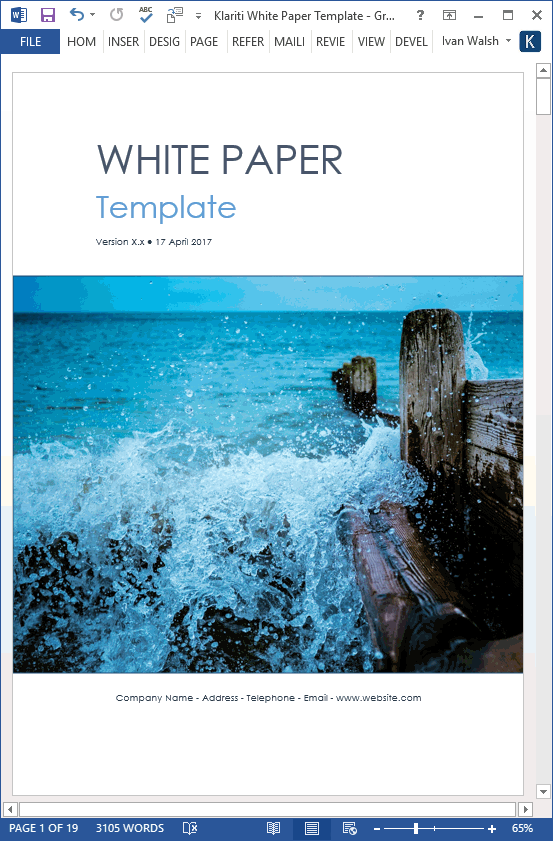White Paper Templates
How to Avoid White Paper Writing Mistakes
What are the most common mistakes when writing white papers? Tone, structure, and voice are common issues for novice writers.
Let’s look at these examples from a white paper and see if we can fix it.
To help you write, format, design, and promote your white papers, we’ve written tutorials, created templates, and made videos.
Green Energy theme – ideal for environmental, health, and energy-related white papers.
White Paper templates – MS Word and Excel
Style and Tone in white papers
What do you notice about the opening paragraphs of this white paper?
First paragraph sample text
Individual management of access to required applications and associated user data is cumbersome, time consuming, and expensive for both individuals and the enterprises supporting the applications.
This approach requires that application support personnel and the user themselves manage not only the individual application accounts, but also the corresponding access rights, passwords, and profile information.
As a result, much of the data managed is duplicated and redundant.
Second paragraph sample text
In day-to-day work and personal interactions, a user’s management of accounts, passwords, and profile data becomes cumbersome quickly.
What do you notice about these writing samples?
Did you find them interesting?
Did you find yourself nodding along in agreement (which is what the writer should be trying to get you to do) or just nodding off?
Strengths and Weaknesses
In the previous examples, the writing is flat, dry, and predictable.
To improve it, we should look at:
- Voice — what is the writing try to say to us? What’s his opinion? What values do he want to share?
- Tone — what tone has the writer taken? Is the tone too severe, too casual, or mix?
- Purpose — where is the writing taking us? Every piece of writing should drive the reader forward in some way. Jargon, clichés, and fillers interfere with this.
How to Improve Clichéd Writing
When we read, we tend to skip over words, verbs, and phrases. We try to get a sense of the article first, a feel for how it’s written, and then, if we find it appealing, go back and read it again with more attention.
What this means for you as a writer, is that you need to:
- Write to be read by readers who scan first and then…
- Write to be read by readers who focus on specific parts of the text and pay close attention what you’ve writing.
This is especially true when writing for the web.
You need to structure your text so that it is appeals to readers (often on mobile devices) who may also print out the article once they get back to the office and read it in more depth.
Skipping and Scanning text
What do skip over text?
We filter out what we don’t need.
We hunt for the specific information we’re after.
While clichés, acronyms, repetition, and jargon do fatten up the page count, they alienate the reader.
At a certain point you lose goodwill and the reader goes elsewhere.
Let’s look at the text. I’ve removed the conjunctions (and, but etc) and articles (the etc).
First paragraph
Individual management access applications associated user data cumbersome, time consuming, expensive individual’s enterprises supporting applications.
approach requires application support personnel user manage not only the individual application accounts, but corresponding access rights, passwords, profile information.
…data is duplicated and redundant.
Second paragraph
work interactions, user’s management accounts, passwords, profile data cumbersome.
What do you notice?
It starts with a negative angle.
That’s fine. Actually, it’s a good way to get the reader’s attention.
But it continues on the same negative track.
Remember, the reader is looking for a solution. They already know there is a problem.
Ideally, we should be heading in that direction.
Then the second paragraph misses its chance.
Instead of providing direction, it rehashes the cumbersome point.
This extract was taken from an otherwise excellent white paper.
I suspect several people were involved in the writing.
Why?
Style, tone, and voice clash.
This Executive Summary is a bit over-written and feels hurried.
Lessons Learned
The lesson for us, as white paper writers, is to:
- Write the narrative in clear, easy to follow language. Make it flow smoothly together from one idea to the next.
- Encourage the reader to keep reading. You can tempt him/her with a little negativity, if it’s written from the right angle; but be careful, and don’t overdo it.
- Finally, make sure you can stand over every word, especially those supplied by other team writers. If not, raise a red flag – but don’t let it out the door.


